MARIANI’S
Virtual Gourmet
NOVEMBER
22, 2015
NEWSLETTER

"Thanksgiving"
by Doris Lee (c.
1935)
IN THIS ISSUE
CHICAGO SHINES, Part Two
By John Mariani
WHAT'S THE WORST FOOD
AND TRAVEL SHOW ON TV?
By John Mariani
NEW YORK CORNER
QUATORZE BIS
By John Mariani
NOTES FROM THE WINE CELLAR
WHAT WOULD THE COLONIALS
DRINK AT THANKSGIVING?
By John Mariani
❖❖❖
CHICAGO SHINES, Part Two
By John Mariani
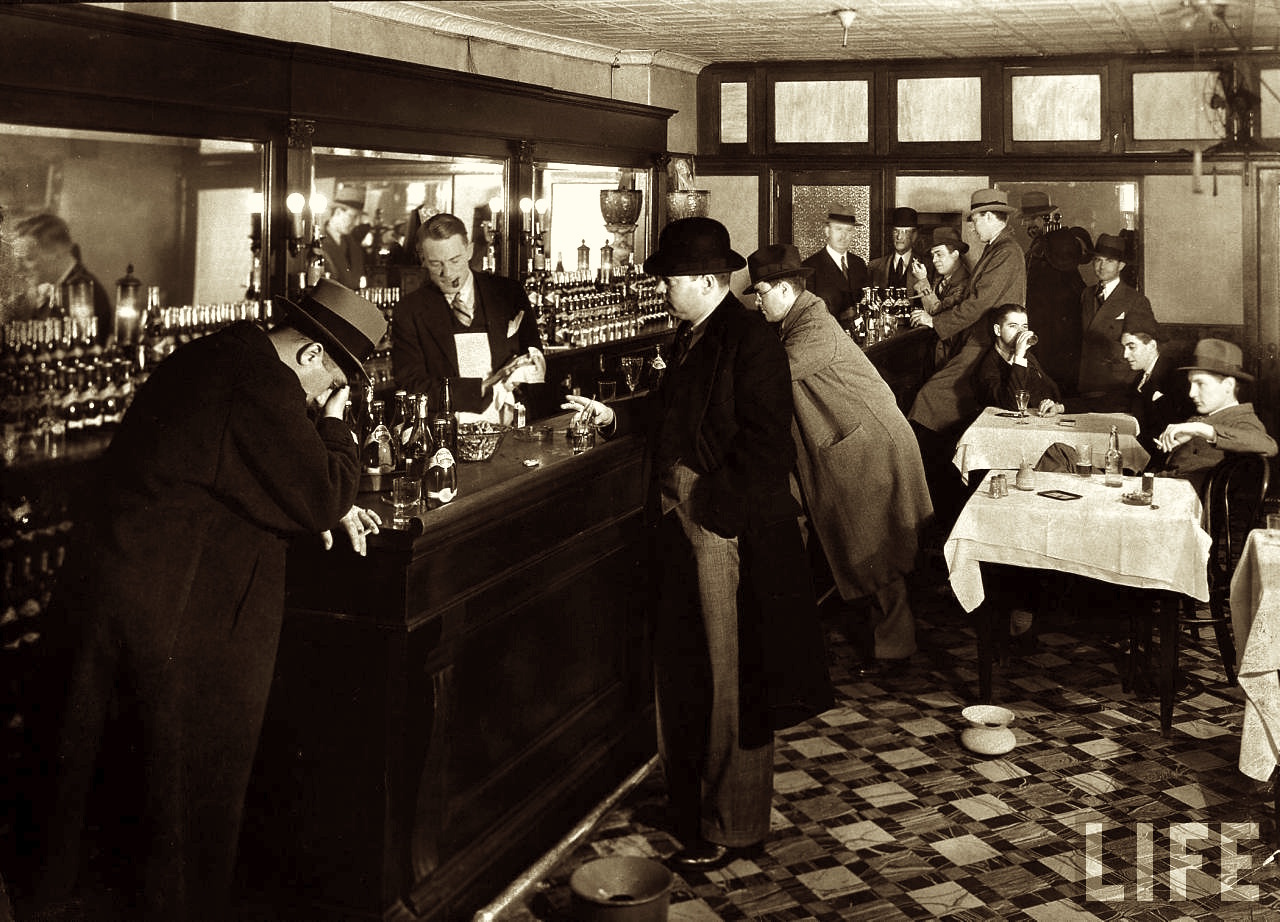
Chicago Speakeasy 1931
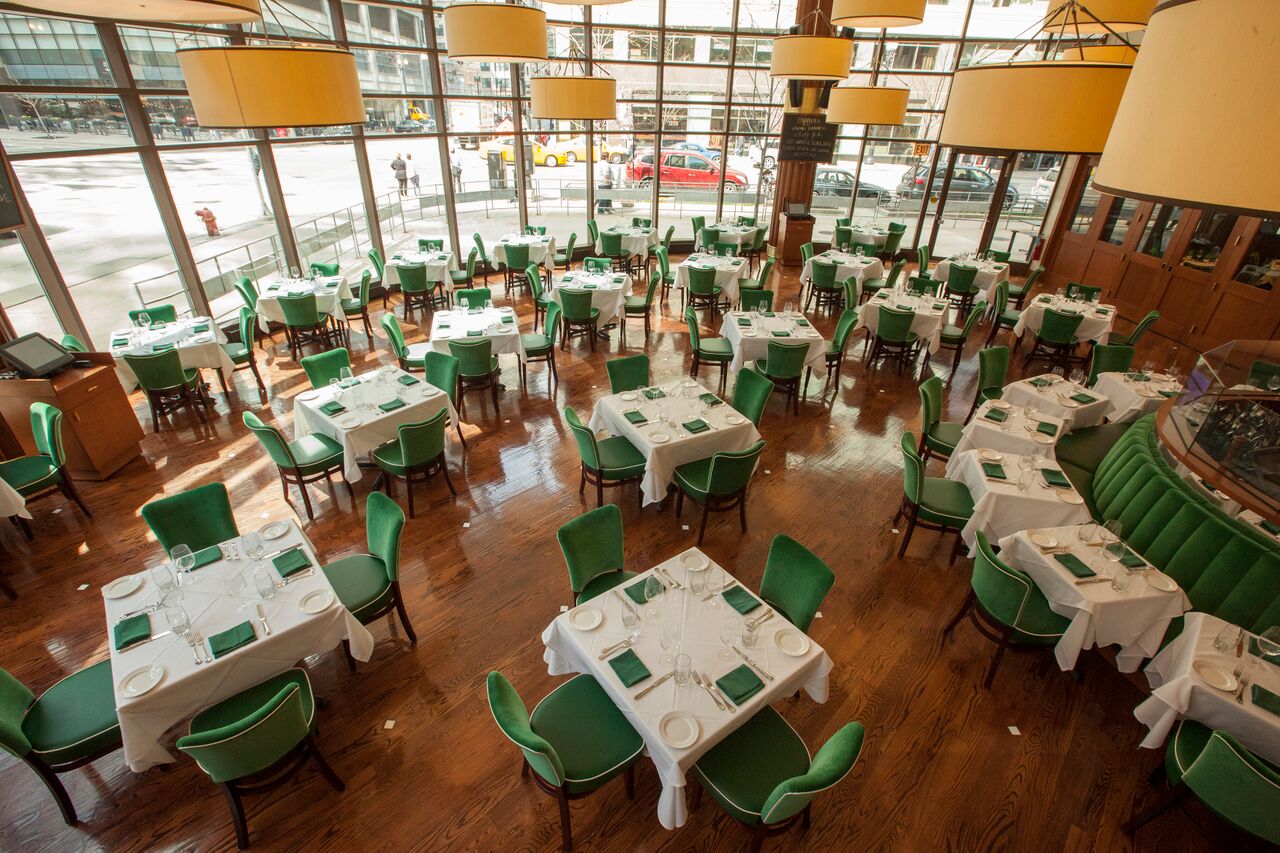 C
Chicago
C
Chicago
20 W Kinzie Street
312-280-8882
cchicago.net
With
the opening of C, David Flom and Matt Moore (below) again
prove themselves among Chicago’s savviest
restaurateurs, not by bankrolling feverish chefs to
mount extravagant, 20-course meals but by focusing
on a simple question: What do people really want to
eat? If
the answer is good, solid, well-prepared food in a
comfortable ambiance, with finely trained servers
and a good wine list, then at both their very
popular Chicago Cut
Steakhouse and now C Chicago, Flom
and Moore have raised the quality level to a plateau
whereby the ingredients speak for themselves and the
kitchen treats them with the utmost respect in the
same way the service staff treats their guests.
When
Cut opened, in a Chicago market saturated with
steakhouses, Flom and Moore added a breathtaking
panorama and décor overlooking the river, with
widely separated tables within a civilized
atmosphere where women felt every bit as much at
home as men who frequent
steakhouses. Cut
was a steakhouse in a finer tone, and it draws a
wide swathe of celebrities, many of whom have become
friends with the owners.
frequent
steakhouses. Cut
was a steakhouse in a finer tone, and it draws a
wide swathe of celebrities, many of whom have become
friends with the owners.
The
seafood-centric C replicates the Cut model in a
gorgeous but not frilly dining room designed by Mark
Knauer—set on two levels like a luxury liner, with a
grand bar, Kelly green upholstery, a stunning metal
shark sculpture, and a display of seafood on ice.
It’s a look that signifies that this is not a
fast-paced raffish spot like Shaw’s Crab House, or
the old-time mariner appeal of the Cape Cod Room. Instead
it’s as modern and refined a dining room as you’ll
find in America right now, a place where when you
walk in you say, “Yes, this is
where I want to eat.”
There’s
been a change of chef—Dean Zanella, formerly of
Chicago Firehouse—since I dined there in October,
but I’m told the menu will stay largely the same.
Our party
of four ate lavishly but at the end felt satisfied
not stuffed, and that’s because the food here is not
overloaded. Octopus à la plancha
was dressed simply with  shaved fennel
and Calabrian sauce
vierge, while lustrous tuna tartare came with
a colorful avocado roulade and wasabi tobiko roe. In early
autumn C
had the extraordinary Spanish prawns called carabineros
(these actually from Moroccan waters), but they are
not due to return to the menu until spring. For now,
big, fat Scottish langoustines of marvelous quality
will do.
shaved fennel
and Calabrian sauce
vierge, while lustrous tuna tartare came with
a colorful avocado roulade and wasabi tobiko roe. In early
autumn C
had the extraordinary Spanish prawns called carabineros
(these actually from Moroccan waters), but they are
not due to return to the menu until spring. For now,
big, fat Scottish langoustines of marvelous quality
will do.
The
cliché “surf and turf” is refreshed here by using
seared A5 Miyazaki beef on a plate with
butter-poached lobster in a citrus demiglace.
The
whole fish selection is enough to cause high
anxiety, for what is one to choose from such an
array? Have the impeccably prepared Dover sole, or
the dorade royale, or see how they render turbot—a
hard fish to get right in this country—by baking it
in an aromatic salt dough. You won’t go wrong with
any.
Side dishes showed every bit of
the same commitment to first-rate ingredients, from
roasted golden beets with espelette
yogurt, sorrel, almonds and fennel tuile to a
warm farro salad with charred corn, heirloom
tomatoes, mustard and whipped feta. 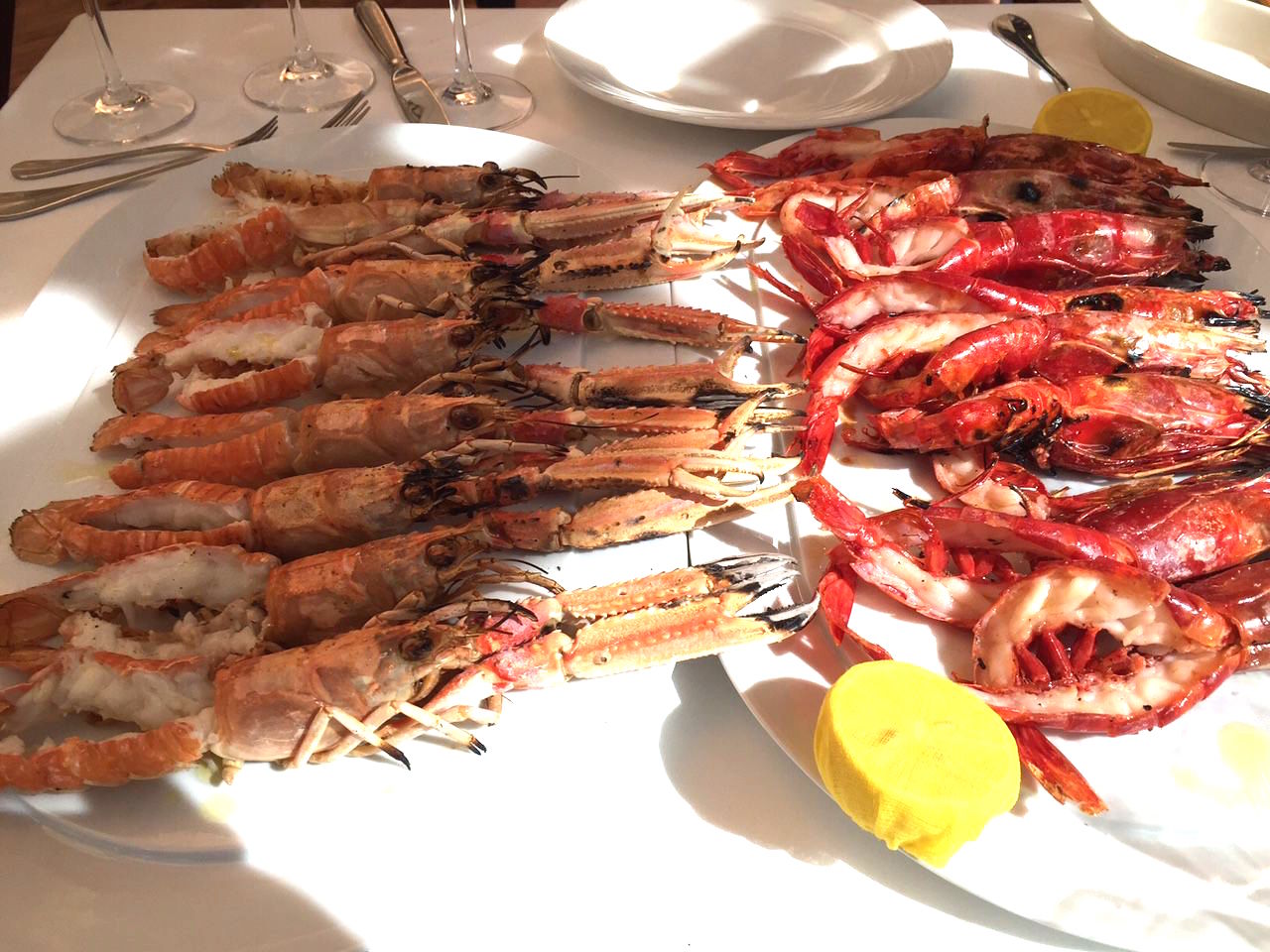
Desserts stay the course with Key
lime pie, pineapple finançier,
chocolate vacherin and strawberry cheesecake.
C’s wine list is exemplary for
the comprehensive way it goes with this food.
Once
you’ve dined at C you will realize all over again
what good food cooked with care can achieve, for
that care takes enormous talent and attention to
detail, and every detail from décor to service makes
C the most admirable restaurant to open in Chicago
in the last couple of years.
Open daily for lunch and dinner.
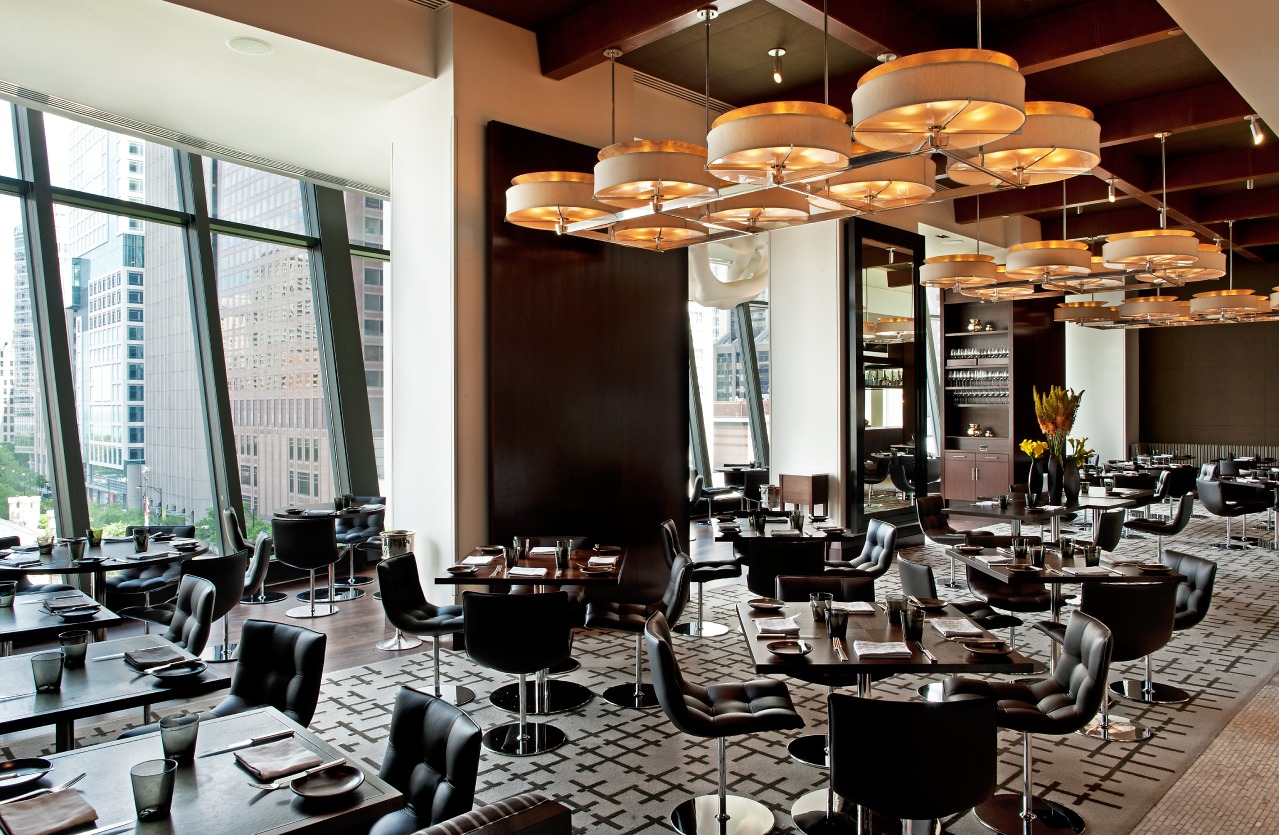 NoMi
NoMi
Park Hyatt Hotel
800 North Michigan Avenue
312-239-4030
hyatt.com/corporate/restaurants/nomi
The name NoMi, for North Michigan,
has taken on a bit more resonance recently with the
appointment of Satoru Takeuchi (below) as
executive chef at the restaurant. NoMi has
always sounded
Japanese and always had a large offering of sushi
and other Japanese dishes on the menu. Now,
under Takeuchi, there is greater emphasis on such
fare without
abandoning the American and European dishes that
give the menu such breadth.
“For me, it’s important that a diner – no
matter how developed or un-developed their palate is
– can taste 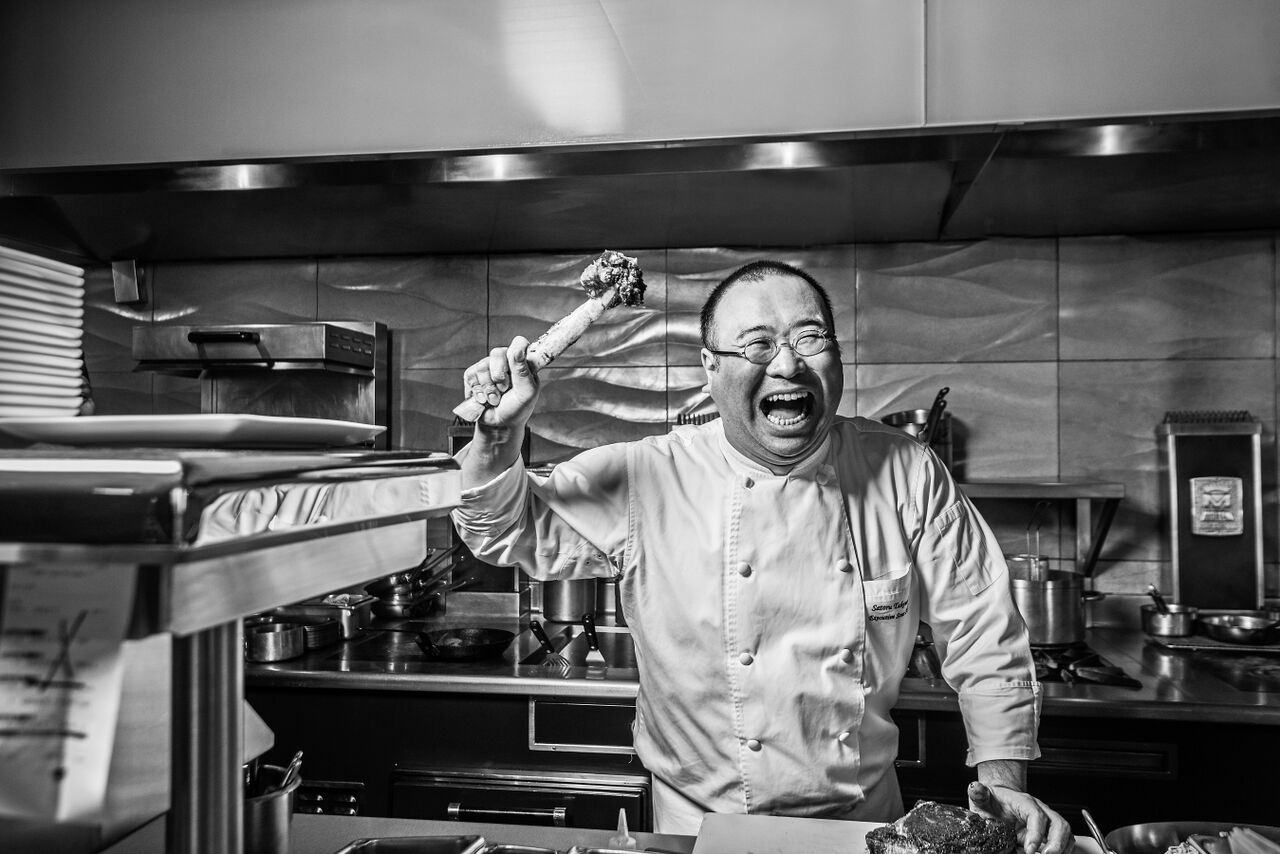 each ingredient that they
see on the description and on the plate,” says
Takeuchi. “I’m not one to over- complicate
dishes. I want the quality and unique tastes
of each product I’m using to shine through.” This is
encouraging at a time when even Japanese chefs are
under media pressure to become fussier and fussier
with more and more ingredients.
each ingredient that they
see on the description and on the plate,” says
Takeuchi. “I’m not one to over- complicate
dishes. I want the quality and unique tastes
of each product I’m using to shine through.” This is
encouraging at a time when even Japanese chefs are
under media pressure to become fussier and fussier
with more and more ingredients.
My
friends and I began with a lavish NoMi platter of
sushi and sashimi ($45)—all
the
right temperature, beautiful texture and thickness,
perfectly seasoned rice—a variety that (on any given
night) might include magoru tuna, sake salmon, hamachi
yellowtail, and
madai snapper (each also offered by the
piece). Hamachi
tataki followed with daikon radish soubise,
the lemony pepper paste called yuzu kosho,
basil-like ohba
pistou, marinated leek and ponzu. There was
also a wonderful, lightly glazed chicken teriyaki
with rice cracker, grilled leek, shichimi
togarashi made from seven peppers, and sesame.
Then
came the western-style dishes, the first via Italy
with a Midwestern ballast—corn agnolotti
with rich mole-glazed pork belly, creamed corn and a
pickled Fresno salad.
Yorkshire porcelet as tender as any I’ve 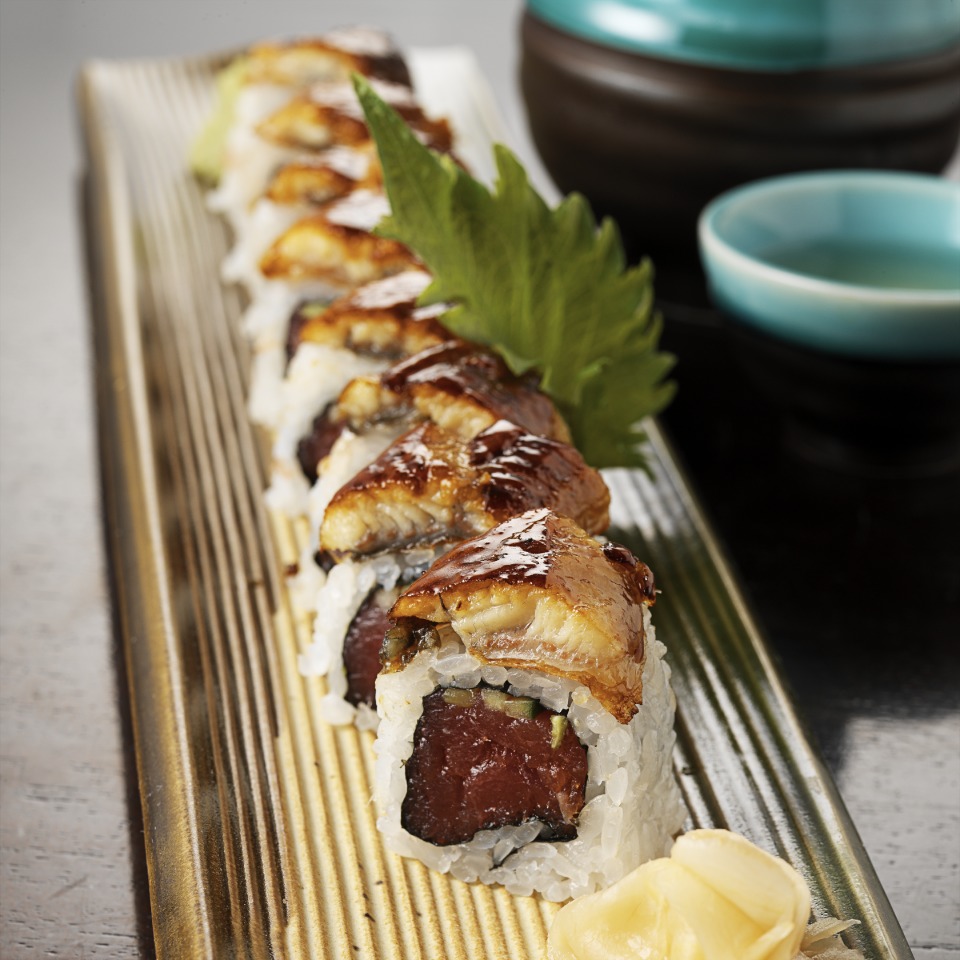 ever had came with a
mustard-flavored spaetzle, chanterelles, spinach and
mustard pork jus,
while King salmon (farm raised, unfortunately) was
pan seared then matched with braised green pea
“française,” Nueske’s ham, orange carrot purée, and
a drizzle of hazelnut oil. Skirt steak picked up its
flavors from a broccoli purée, broccoli di rabe,
charred broccoli, glazed white pearl onions and
pepper beef jus;
grass fed, the beef hadn’t much taste on its own.
ever had came with a
mustard-flavored spaetzle, chanterelles, spinach and
mustard pork jus,
while King salmon (farm raised, unfortunately) was
pan seared then matched with braised green pea
“française,” Nueske’s ham, orange carrot purée, and
a drizzle of hazelnut oil. Skirt steak picked up its
flavors from a broccoli purée, broccoli di rabe,
charred broccoli, glazed white pearl onions and
pepper beef jus;
grass fed, the beef hadn’t much taste on its own.
Greg
Mosko’s desserts were, as expected, very much in the
generous Midwestern style—apple and pomegranate
sautéed apple, caramelized and creamed white
chocolate, tangy
spiced apple cider, cinnamon cake and walnut—quite a
display of goodness all on one plate. But there
was also a rich flourless chocolate tart, decadently
dense, with dark chocolate ganache, blackberries and
both a citrusy gel and finger lime to bring up the
brightness of flavors. Loveable in every way was a
plum sheep’s milk cheesecake with sesame graham
cracker, yuzu
gel, fresh plums, coconut dacquoise and a touch of shiso.
The term “fusion food”
has gone out of fashion, but that may be because
chefs like Takeuchi
perform their magic of stylistic marriage so
flawlessly that eccentricity takes a back seat to
pure, good taste.
Open daily for
breakfast, lunch and dinner.
WHAT'S THE WORST FOOD AND TRAVEL SHOW ON TV?
By John Mariani
 Who am I to
judge?
Who am I to
judge?
“This has got to be the worst TV show
ever!” That is
the statement made by Philip Rosenthal himself in
the middle of his new PBS series with the
grotesque title “I’ll Have What Phil’s Having,” in
which he and a jerking, hand-held camera crew
visit various cities à la Anthony Bourdain on CNN
but without that series’ production budget.
According to his biography, Rosenthal’s
principal claim to dubious fame involves writing
episodes of Everybody
Loves Raymond.
Nothing
in his on-line résumé in any way suggests he would
be even an adequate host of a globe-trotting food
show, and in episode after episode he manifests
everything that is now so appalling about the
“hey-anybody-can-do-this” world of food TV.
Granted, the majority of the shows on Food Network
are unwatchable—largely repeats of Guy Fieri
supermarket contests, useless competitons, and
“Pioneer Woman”—but “I’ll Have What Phil’s Having”
is one you watch in awe of the ineptitude, the
ignorance and the hyperbole that characterizes
this kind of show.
In Paris Rosenthal, dressed like a guy
going to Starbucks after a sweaty jog, traipses
around the city (“Look at French people!” he
remarks) to spend a moment here, a moment there. He sits
down at the great (but empty) restaurant Arpége
and goes on about the glory of a single dessert,
all the while tossing out “wow” and “awesome” and
other hyperboles with the abandon of a carnie
hustler.
He visits a chocolate shop but
says nothing but “wow,” a cheese shop where he
goes ga-ga over the 100 varieties arrayed, and
then, for no reason one can imagine, goes jogging
around Paris for several of the show’s 54 minutes.
He sits with expat American David
Liebovitz, who contends that good croissants
should never be curved, which is idiotic since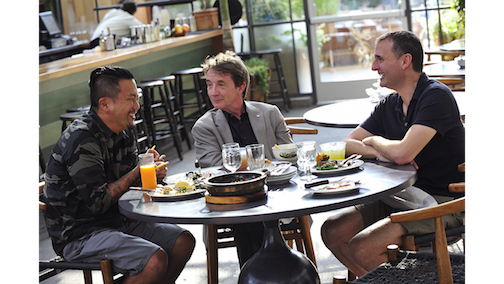 the word “croissant” means
crescent. They
take a bite, then it’s off to the next stop.
the word “croissant” means
crescent. They
take a bite, then it’s off to the next stop.
One gets the feeling this
cheapo production was made in one day, with
Rosenthal having culled all his knowledge of
Parisian gastronomy from recommendations on Trip
Advisor.
In
Barcelona he spends five minutes talking to his
mother and father by Skype about cancelling their
Verizon account!
In Italy he describes his attempt at making
pasta as, “Schmucko is going to try his hand at
making this beautiful delicate thing.”
In a show about Los Angeles, a trip to a
Korean eatery is with comedian Martin Short (right), whose
reaction is nothing short of horror, saying, “I
want to wake up in the morning and live.” Rosenthal
goes to Langer’s deli with Norman Lear and
exclaims, “Holy crap! It’s like a bar mitzvah!”
with repeated exclamations of “Oh, my God!” In
a show set in Hong Kong he spends a chunk of time
by going to a holistic medicine store, and
wonders, “How can I sleep through the night
without going to the bathroom?” He plays the
schlemiel, like Adam Sandler with even less wit.
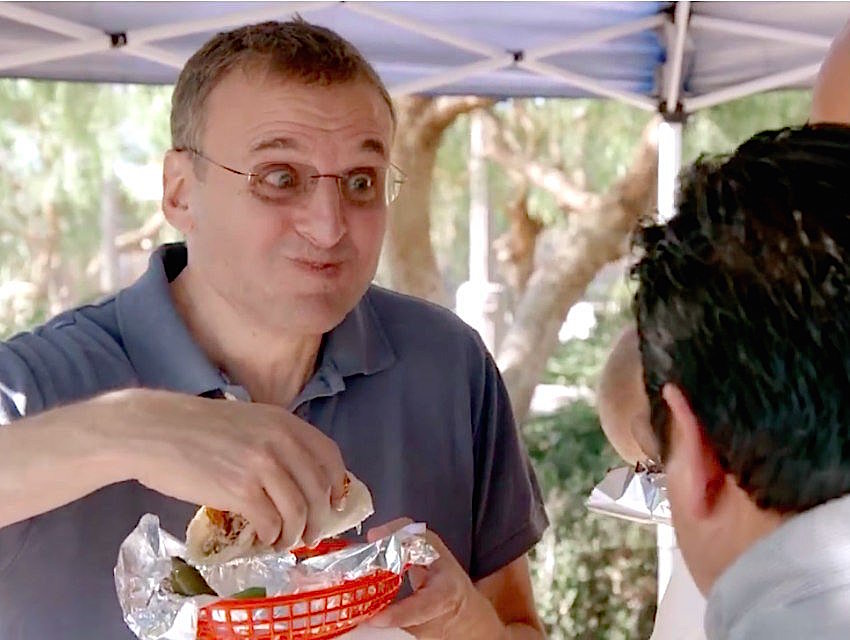 Unlike Rick
Steves’ superbly produced, tightly edited and
extremely informative travel shows on TV,
Rosenthal’s looks as if made by a guy with some
money to spend on a lark.
Unlike Rick
Steves’ superbly produced, tightly edited and
extremely informative travel shows on TV,
Rosenthal’s looks as if made by a guy with some
money to spend on a lark.
What
viewers probably realize is that PBS pays for very
few of the productions it broadcasts. (“Downton
Abbey” is a co-production of Carnival Films and
Masterpiece Theater.) To get on PBS an individual
must mount his own production, get his own
sponsors, then just give it all
over to PBS to broadcast, with no cost to the
network. Which
explains why, among the very good shows it
broadcasts, there are so many amateurish ones,
particularly on food and travel.
Rosenthal’s
show is slicker than some, but more banal than
most. You
see a lovely shot of a piece of pastry or a slice
of cheese but learn nothing about it. The
show is more like a packet of cheap colorized
postcards you’d buy from a souvenir shop than a
learning experience, which is what PBS is
supposedly about.
So, is, as Rosenthal says, his show the
worst show on TV ever? It’s certainly right up
there. . . . but it
still has a long way to go to beat “Master
Chef Junior.” Ba-da-boom!
By John Mariani
QUATORZE BIS
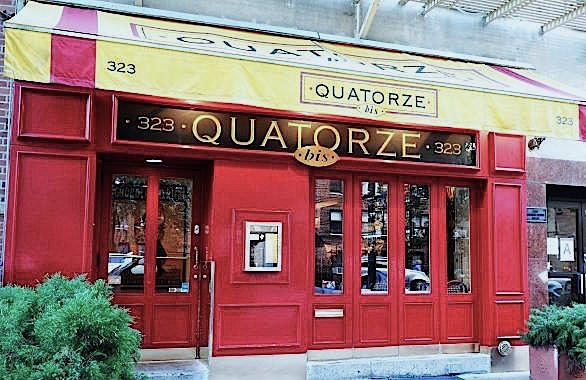
323 East 79th Street (near 2nd Avenue)
212-535-1414
People
love true bistros because they are small, often
family-owned neighborhood eateries, where the food
is always simple and full of flavor, with certain
classics dependably on the menu. Even the
particular look and typography on the menus seems
almost sacrosanct.
Bistros are never dark, so that
you can see everyone coming and going. The pace is
fast, the wines are regional, and the greeting
warm. There’s usually Edith Piaf or Charles
Aznevour singing in the background.
You bring to a bistro whatever mood
you're in, and then you shake it free or stir it
up. When you feel gregarious, a bistro buoys you.
When you feel blue, the gaiety of the place and
the first aperitif brings you back from the brink.
The waiters all have stories to tell, but, you
think, never about you. And because bistros all
share so very much in common, they make you feel
hungry and happy and at home, wherever you are in
the world.
Now a quarter-century old,
Quatorze Bis (the name is from its original
address on Fourteenth Street, and “bis” means the
second one) is as bright and cheery as ever,
always full, seven days a week, largely with an
Upper East Side crowd of regulars who are never
disappointed because little ever changes within
this cocoon-like bistro.
Its deep red façade is typical,
as are the French posters inside, the tables are
clothed in white, the chairs are sturdy. The
wineglasses are imprinted with the restaurant’s
name. A small marble-topped bar is up front, next
to the hostess station. Mirrors open up the space. There
is a peppermill on every table. Quatorze
Bis does lack the traditional brass railings and
lace curtains of Parisian stereotypes, but beyond
that it’s easy enough to think you are in some
favorite arrondissement where everyone is speaking
French and tourists are few.
The waiters are amiable and
brisk, they tell you the specials, which are also
scribbled on little blackboards on your table, and
there are plenty of decently priced wines to go
with the hearty food served here.
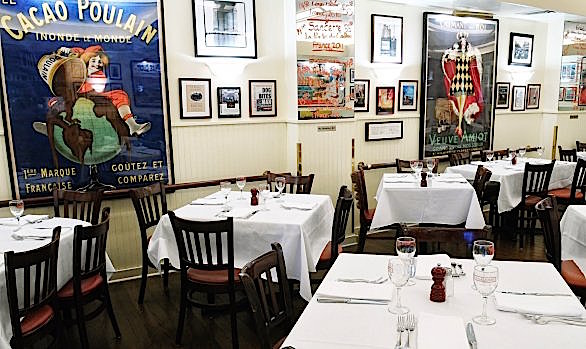 You sit
down and the busboy brings sliced bread and a
generous slab of butter. The wine comes, you peruse
the menu, unable to choose among so many classic
dishes, from seafood sausage to duck confit. Our
party began with a velvety duck mousse in a
ramekin with toasted bread that hit the spot on an
autumn evening.
Light and refreshing was the celery
rémoulade, with a tangy mayonnaise. A dish
that bistros like Quatorize Bis have served for
decades—a creamy, cheese-rich Gruyère and onion
tart—seems suddenly to have been re-discovered by
a lot of contemporary restaurants; QB’s is still
one of the best.
You sit
down and the busboy brings sliced bread and a
generous slab of butter. The wine comes, you peruse
the menu, unable to choose among so many classic
dishes, from seafood sausage to duck confit. Our
party began with a velvety duck mousse in a
ramekin with toasted bread that hit the spot on an
autumn evening.
Light and refreshing was the celery
rémoulade, with a tangy mayonnaise. A dish
that bistros like Quatorize Bis have served for
decades—a creamy, cheese-rich Gruyère and onion
tart—seems suddenly to have been re-discovered by
a lot of contemporary restaurants; QB’s is still
one of the best.
How much more classic can you
get than boeuf
bourguignon? QB’s version is textbook
perfect, hefty in its mixture of long-simmered
beef, onions, red wine and seasonings, with a true
Burgundian soulfulness.
There is a fish of the day, which may be
had simply grilled, sautéed à la meunière
or amandine. My
friend chose the last, which turned out to be mahi
mahi that evening, beautifully cooked and showered
with almonds tossed in brown butter.
One of the signature items at
QB all these years has been its choucroute
garnie (below), which right
about now is exactly what I want to eat as we
nudge towards the end of November. It was
a splendid platter of Alsatian sausages—the waiter
suggested I get them grilled, and he’s right: too
often choucroute
sausages merely get cooked with the sauerkraut
and lack much dimension. These were delicious, with a
real snap to the skin, cuddled in the tangy, winey
sauerkraut. 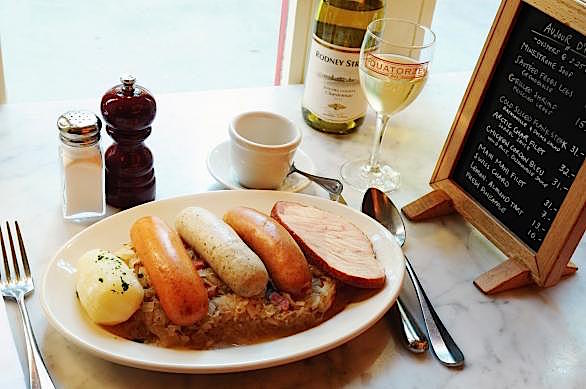
For
dessert there is hot apple tart, an old-fashioned
chocolate mousse, crème caramel, poached pear, and
my constant go-to in a bistro: plump, ice-cream
filled profiteroles of puff pastry lavished with
dark chocolate sauce.
It is inevitable that the one
thing that always changes in restaurants is the
price, and it’s daunting to see what twenty-five
years of increases in the cost of living,
salaries, and ingredients can do. In
looking at an old QB menu from 1990, I found the choucroute
was $16, today it is $32; then a grilled sirloin
with Béarnaise and pommes frites
was $22, now it’s $45; desserts used to be $5 or
$6, now they are $12.50 to $14.50. Zut alors,
que peut-on faire?
It may well be twenty years since I was
last at Quatorze Bis, and I’m sure there have been
some decorous changes, but I really didn’t notice
because the gaiety and bonhomie of the place is
exactly as I remember it, as is the food. That’s
a rare thing anywhere and in ever-mutating NYC
something to be cherished.
Open for lunch and dinner daily.
❖❖❖
DRINK AT THANKSGIVING?
By John Mariani
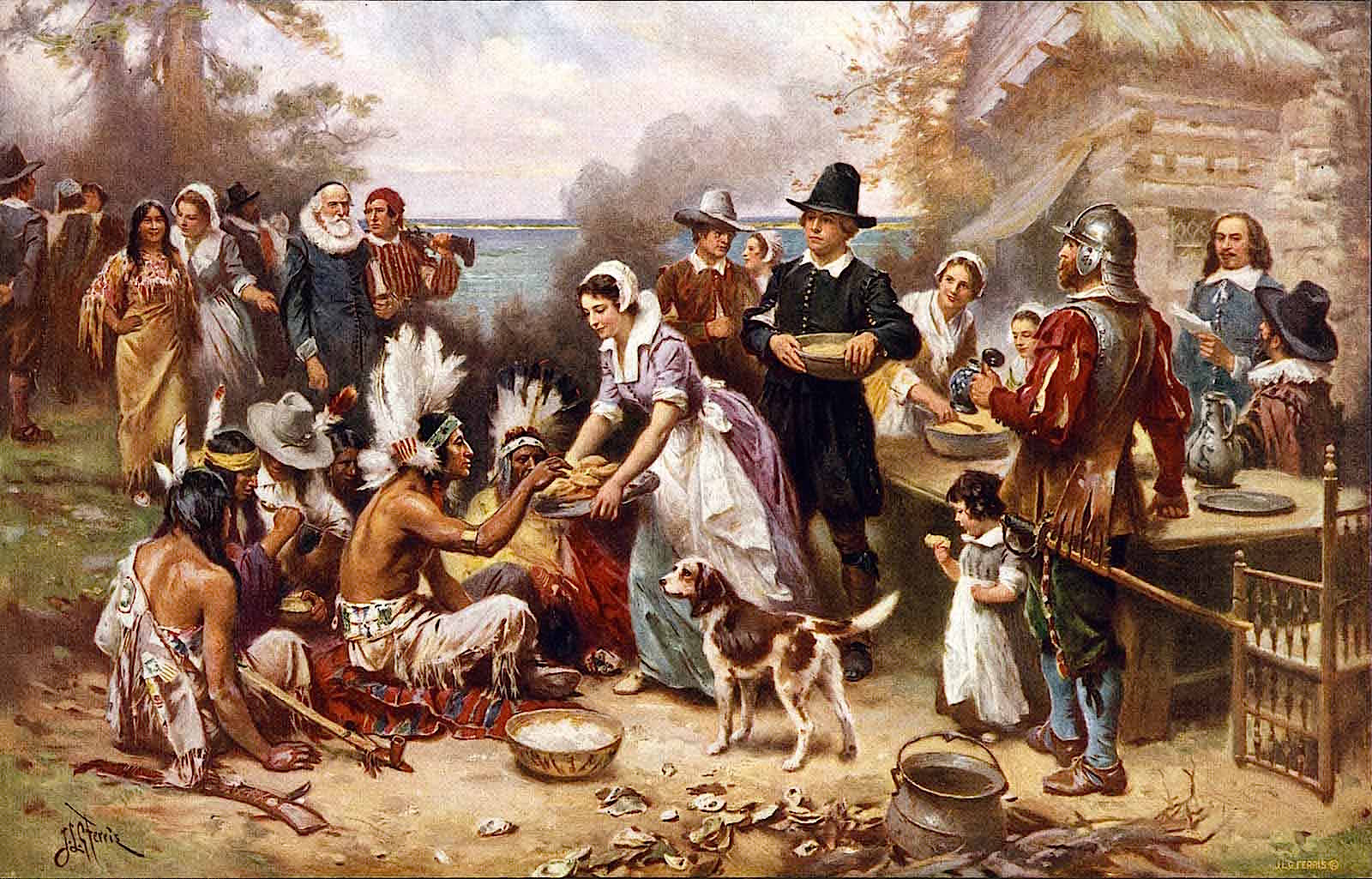
You’re not likely to find it in
schoolbooks, but the real reason the Pilgrims
landed at Plymouth Rock in 1620 was because they
ran out of beer. In the Mayflower’s
log is found the notation that the Pilgrims 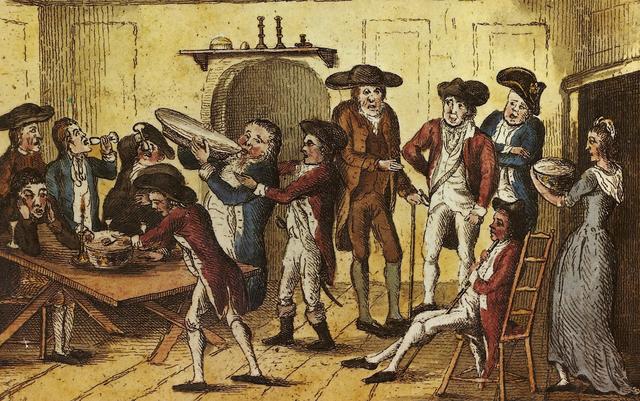 landed where they did because "We
could not take much time for further search, our
victuals being much spent, especially beer.”
landed where they did because "We
could not take much time for further search, our
victuals being much spent, especially beer.”
Before long, however, they were making beer
from maize, spruce or birch. By 1637 the Colony had
two licensed breweries. Temperance vied with
drunkenness almost as soon as the Puritans settled
in. Taverns and churches were opened in equal
numbers.
At the first Thanksgiving dinner in the
autumn of 1621, the Pilgrims probably drank sweet
wine made from wild native Labrusca grapes and with
their Indian friends feasted on oysters, cornbread,
eel, goose, venison, watercress, leeks, berries and
plums. Turkey was not specifically mentioned but was
most probably part of the meal.
The early colonists certainly drank wines
based on native grapes like Concord and Catawba, but
European wines were quickly imported. In 1632 Gov.
John Winthrop of Massachusetts decreed that
Governor’s Island in Boston Harbor be devoted to
wine production.
The colonials
would certainly have had access to European wines.
In fact, Capt. John Smith, in his Sea Grammar
of 1627, recommended all incoming ships from Europe
bring onboard “fine wines.”
The British already had a long history as
importers and exporters of Portuguese wines and the
technique of making Port wine by adding brandy to
red wine was the work of a Liverpool wine merchant
in 1678. As a result, many Port companies, like
Cockburn, Sandeman, Croft, and Taylor Fladgate, have
British names, as do many Madeira and Spanish Sherry
companies.
 The
colonists would also have ample access to locally
produced cider, both fermented and unfermented, and
ginger beer, as well as imported brandies and
“London Dry Gin,” so-called because it was made near
London.
The
colonists would also have ample access to locally
produced cider, both fermented and unfermented, and
ginger beer, as well as imported brandies and
“London Dry Gin,” so-called because it was made near
London.
Rum, a
product of the Caribbean, was widely drunk. By 1657
it was also being made in New England, which was
part of the highly profitable Triangular Trade of
shipping rum to Europe to make money to buy slaves
in Africa who were sent to the Caribbean to work the
American sugar plantations to make molasses as the
base for rum distillation.
So, if one wants to be very traditional about
celebrating Thanksgiving in the style of the
pre-Revolutionary War colonists, you have a wide
range of beverages to choose from. This year
I’ve decided to serve an array of libations at my
Thanksgiving table based on pre-1776 models and
menus.
Therefore, when my guests arrive I will serve
them cocktails (beverages that date back before
1800) made with either London Dry Gin like Beefeater ($19)
or a rum like Bacardi Gold
($25). I’ll mix the gin with quinine tonic, for
quinine was discovered to be essential onboard
British ships to prevent scurvy. I’ll make a rum
punch with citrus fruits and spices, a beverage
known in print at least since 1625. An ad in
The Salem
Gazette for 1741 noted that orange juice was
becoming preferred to lemon juice in the fashionable
punches of the day.
The colonists favored
fortified wines, that is, wines that could travel
the seas because they were stabilized with the
addition of 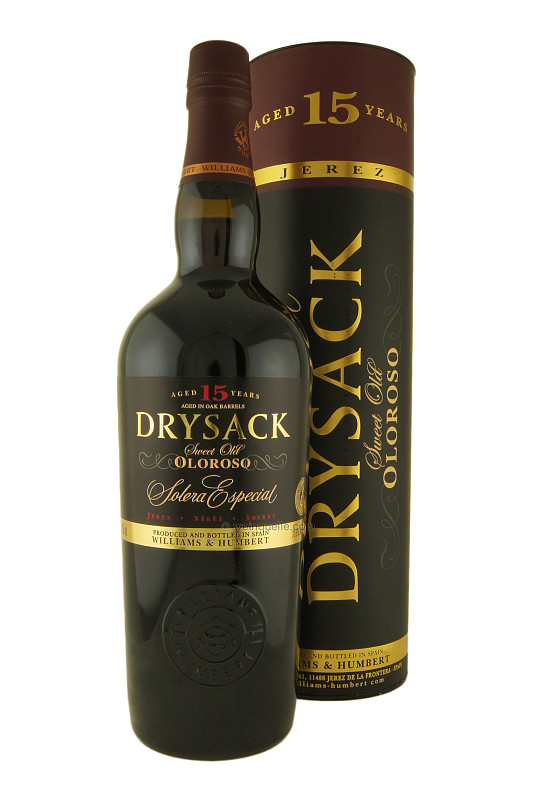 brandy, William and Humbert
make a superb Dry
Sack Oloroso Solera Especial ($25), made
from a blend of oloroso and Pedro Jimenez
Sherries, and a Dos Cortados Palo 20 Years Old Especial
Sherry ($45), from the palomino
grape, of a kind that would have been served
at a good feast anywhere in the
colonies.
brandy, William and Humbert
make a superb Dry
Sack Oloroso Solera Especial ($25), made
from a blend of oloroso and Pedro Jimenez
Sherries, and a Dos Cortados Palo 20 Years Old Especial
Sherry ($45), from the palomino
grape, of a kind that would have been served
at a good feast anywhere in the
colonies.
We
will then sit down to dinner, where I will serve a
New York State Finger Lakes Riesling like Dr. Konstantin
Frank’s Semi-Dry Riesling 2014 ($15) to go
with the cream of watercress soup we’ll begin with. For the
turkey course, which will have as many sweet as
savory flavors in the stuffing, cranberry sauce, and
sweet potatoes, I’ll serve a Virginia wine from a
European varietal--Barboursville
Vineyards’ elegant Octagon 2012
($55), a blend of Merlot, Cabernet Franc, and
Cabernet Sauvignon, made from vineyards on land that
was once the 870-acre plantation of Gov. James
Barbour, whose mansion was designed by Thomas
Jefferson.
Then will come the cheese course—a sharp,
aged Vermont Cheddar from Cabot Cheese in
Montpelier, with glasses of either a Taylor Fladgate Late Bottle Vintage
Port 2007 ($75), which
will carry over nicely with the traditional desserts
of apple pie and pumpkin pie. Then,
after coffee, for those still in a celebratory mood,
I shall bring out snifters of a fine, well-aged dark
rum, like Plantation 8 Year Rum from
Jamaica ($25)
or sophisticated
flavor of Cruzan Single Barrel Premium Extra Aged
Rum ($20) from St. Croix.
I might also choose an aged
Kentucky bourbon, America’s only indigenous spirit
(even if bourbon really  wasn’t made
until after the Revolutionary War; nor was Kentucky
one of the original Colonies.) In any case, one of
the lighter, easy-to-drink bourbons is Basil Hayden
($45), 80 proof, which is currently offering a
Limited Edition (100 units) Drinking Shoe set of
four leather-wrapped rocks glasses in a custom gift
box and a pair of custom-made Basil Hayden leather
moccasins made by Quoddy, at $399. Or Angel's
Envy Bourbon ($169) finished in Port
barrels and released at cask strength--a whopping
127.9 proof! Of course, the Anglo-Scots brought Scotch
whiskey to America, and the array in the U.S. market
is bigger than ever. My absolute favorite (at
least for the moment) is Oban 14 Single Malt Whiskey ($75)
which I find has an exquisite balance of grain,
smoke, peat, and spice that flows over the palate.
wasn’t made
until after the Revolutionary War; nor was Kentucky
one of the original Colonies.) In any case, one of
the lighter, easy-to-drink bourbons is Basil Hayden
($45), 80 proof, which is currently offering a
Limited Edition (100 units) Drinking Shoe set of
four leather-wrapped rocks glasses in a custom gift
box and a pair of custom-made Basil Hayden leather
moccasins made by Quoddy, at $399. Or Angel's
Envy Bourbon ($169) finished in Port
barrels and released at cask strength--a whopping
127.9 proof! Of course, the Anglo-Scots brought Scotch
whiskey to America, and the array in the U.S. market
is bigger than ever. My absolute favorite (at
least for the moment) is Oban 14 Single Malt Whiskey ($75)
which I find has an exquisite balance of grain,
smoke, peat, and spice that flows over the palate.
If there are any beer drinkers at the feast,
they can choose a pale ale or stout over lager,
which was not made in America until about 1840.
Dining
this well, with these wines and spirits, it is easy
to be thankful for what the American colonists set
in motion nearly four centuries ago.
❖❖❖
 MAYBE SHE
THREATENED HIM WITH A PLASTIC SPOON!!
MAYBE SHE
THREATENED HIM WITH A PLASTIC SPOON!!
FOOD
WRITING 101: STIFLE YOUR URGE TO WRITE LIKE
TOM WAITS, UNLESS YOU ARE TOM WAITS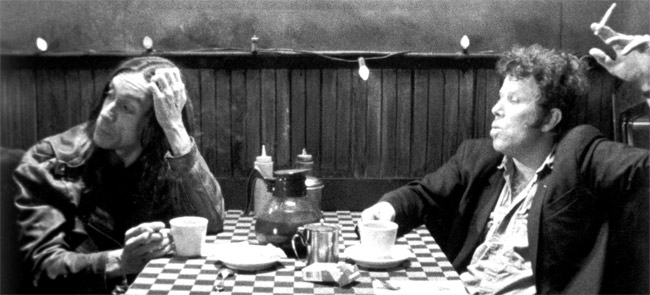
"We drink our rosé and moan about how
full we are and wonder if it would have been
unprofessional to slip Keanu a number as we listen to
fireworks exploding out of sight, and we enjoy being
miserable together.”—Jessie Kissinger and Anna Peele, “3
Restaurants, 1 Night,” Esquire (Nov
2015).
Any of John Mariani's books below may be ordered from amazon.com.
 I'm proud and happy to announce that my
new book, The Hound
in Heaven (21st Century Lion Books), has just
been published through Amazon and Kindle.
I'm proud and happy to announce that my
new book, The Hound
in Heaven (21st Century Lion Books), has just
been published through Amazon and Kindle. It is a novella, and for anyone who loves dogs, Christmas, romance, inspiration, even the supernatural, I hope you'll find this to be a treasured favorite. The story concerns how, after a New England teacher, his wife and their two daughters adopt a stray puppy found in their barn in northern Maine, their lives seem full of promise. But when tragedy strikes, their wonderful dog Lazarus and the spirit of Christmas are the only things that may bring back his master back from the edge of despair.
WATCH THE VIDEO!
“What a huge surprise turn this story took! I was completely stunned! I truly enjoyed this book and its message.” – Actress Ali MacGraw
“He had me at Page One. The amount of heart, human insight, soul searching, and deft literary strength that John Mariani pours into this airtight novella is vertigo-inducing. Perhaps ‘wow’ would be the best comment.” – James Dalessandro, author of Bohemian Heart and 1906.
“John Mariani’s Hound in Heaven starts with a well-painted portrayal of an American family, along with the requisite dog. A surprise event flips the action of the novel and captures us for a voyage leading to a hopeful and heart-warming message. A page turning, one sitting read, it’s the perfect antidote for the winter and promotion of holiday celebration.” – Ann Pearlman, author of The Christmas Cookie Club and A Gift for my Sister.
“John Mariani’s concise, achingly beautiful novella pulls a literary rabbit out of a hat – a mash-up of the cosmic and the intimate, the tragic and the heart-warming – a Christmas tale for all ages, and all faiths. Read it to your children, read it to yourself… but read it. Early and often. Highly recommended.” – Jay Bonansinga, New York Times bestselling author of Pinkerton’s War, The Sinking of The Eastland, and The Walking Dead: The Road To Woodbury.
“Amazing things happen when you open your heart to an animal. The Hound in Heaven delivers a powerful story of healing that is forged in the spiritual relationship between a man and his best friend. The book brings a message of hope that can enrich our images of family, love, and loss.” – Dr. Barbara Royal, author of The Royal Treatment.
 |
The Encyclopedia of American Food and Drink by John F. Mariani (Bloomsbury USA, $35) Modesty forbids me to praise my own new book, but let me proudly say that it is an extensive revision of the 4th edition that appeared more than a decade ago, before locavores, molecular cuisine, modernist cuisine, the Food Network and so much more, now included. Word origins have been completely updated, as have per capita consumption and production stats. Most important, for the first time since publication in the 1980s, the book includes more than 100 biographies of Americans who have changed the way we cook, eat and drink -- from Fannie Farmer and Julia Child to Robert Mondavi and Thomas Keller. "This book is amazing! It has entries for everything from `abalone' to `zwieback,' plus more than 500 recipes for classic American dishes and drinks."--Devra First, The Boston Globe. "Much needed in any kitchen library."--Bon Appetit. |
"Eating Italian will never be the same after reading John Mariani's entertaining and savory gastronomical history of the cuisine of Italy and how it won over appetites worldwide. . . . This book is such a tasteful narrative that it will literally make you hungry for Italian food and arouse your appetite for gastronomical history."--Don Oldenburg, USA Today. "Italian
restaurants--some good, some glitzy--far
outnumber their French rivals. Many of
these establishments are zestfully described
in How Italian Food Conquered the World, an
entertaining and fact-filled chronicle by
food-and-wine correspondent John F.
Mariani."--Aram Bakshian Jr., Wall Street
Journal.
"Equal parts
history, sociology, gastronomy, and just
plain fun, How Italian Food Conquered the
World tells the captivating and delicious
story of the (let's face it) everybody's
favorite cuisine with clarity, verve and
more than one surprise."--Colman Andrews,
editorial director of The Daily
Meal.com. "A fantastic and fascinating
read, covering everything from the influence
of Venice's spice trade to the impact of
Italian immigrants in America and the
evolution of alta cucina. This book will
serve as a terrific resource to anyone
interested in the real story of Italian
food."--Mary Ann Esposito, host of PBS-TV's
Ciao
Italia. "John Mariani has written the
definitive history of how Italians won their
way into our hearts, minds, and
stomachs. It's a story of pleasure over
pomp and taste over technique."--Danny Meyer,
owner of NYC restaurants Union Square
Cafe, The Modern, and Maialino.
|
 |
 |
 |
 |
 |
 |
 |
 |
 Everett Potter's Travel Report:
Everett Potter's Travel Report: 
 Eating Las Vegas
is the new on-line site for Virtual Gourmet
contributor John A. Curtas., who since 1995
has been commenting on the Las Vegas food
scene and reviewing restaurants for Nevada
Public Radio. He is also the
restaurant critic for KLAS TV, Channel 8 in
Las Vegas, and his past reviews can be
accessed at KNPR.org.
Click on the logo below to go directly to
his site.
Eating Las Vegas
is the new on-line site for Virtual Gourmet
contributor John A. Curtas., who since 1995
has been commenting on the Las Vegas food
scene and reviewing restaurants for Nevada
Public Radio. He is also the
restaurant critic for KLAS TV, Channel 8 in
Las Vegas, and his past reviews can be
accessed at KNPR.org.
Click on the logo below to go directly to
his site.

Tennis Resorts Online: A Critical Guide to the World's Best Tennis Resorts and Tennis Camps, published by ROGER COX, who has spent more than two decades writing about tennis travel, including a 17-year stretch for Tennis magazine. He has also written for Arthur Frommer's Budget Travel, New York Magazine, Travel & Leisure, Esquire, Money, USTA Magazine, Men's Journal, and The Robb Report. He has authored two books-The World's Best Tennis Vacations (Stephen Greene Press/Viking Penguin, 1990) and The Best Places to Stay in the Rockies (Houghton Mifflin, 1992 & 1994), and the Melbourne (Australia) chapter to the Wall Street Journal Business Guide to Cities of the Pacific Rim (Fodor's Travel Guides, 1991).


MARIANI'S VIRTUAL GOURMET
NEWSLETTER is published weekly. Editor/Publisher: John
Mariani.
Editor: Walter Bagley. Contributing Writers: Christopher Mariani,
Robert Mariani, Misha
Mariani,
John A. Curtas, Edward Brivio, Mort Hochstein,
Andrew Chalk, Dotty Griffith and Brian Freedman. Contributing
Photographers: Galina Dargery, Bobby
Pirillo. Technical Advisor: Gerry McLoughlin.
To un-subscribe from this newsletter,click here.
© copyright John Mariani 2015

